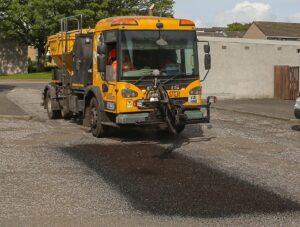Local authority highway teams in England and Wales only received around two-thirds of what they needed to stop the local roads from further deterioration and that more than £14 billion is now needed to fix the backlog of carriageway repairs.
This year’s Annual Local Authority Road Maintenance (ALARM) published today (March 21, 2023) by the Asphalt Industry Alliance (AIA), reports that despite the small increase in overall highway maintenance budgets
reported, less is being spent on the carriageway itself and rising costs due to inflationary pressures mean engineers have reported being forced to postpone or cancel road schemes to make savings.
The data shows that in the last year, the gap between what local authorities received and what they said they would have needed to keep roads to their own target conditions and prevent further decline is now £1.30 billion – a jump of more than 20% on last year’s figure and the highest amount reported in 28 years of successive ALARM surveys.
And, the cost of fixing the backlog of carriageway repairs is reported to
have increased by a further 11% on last year’s record figure to a new high of £14.02 billion – the equivalent of £68,000 per mile of local road in England and Wales – and would take an average of 11 years to complete.
Rick Green, AIA Chair, said: “Highway engineers can only do so much with the resources they are given and should be applauded for the steps they make to keep roads safe.
“Potholes and the condition of our local roads remain key issues for the
public and the Chancellor went someway to recognising this in his Spring
Budget. But the additional £200m one-off payment for local roads in
England, while welcome, is just not enough. It represents around 20% of
the average shortfall in English local authorities’ annual budgets and will do little to improve overall structural conditions and stem further decline,” he added.
The findings of ALARM 2023, which relate to the 2022/23 financial year, show that in England and Wales:
• Local authorities would have needed an average of an extra £7.7 million each last year just to reach their own
target road conditions.
• It would now cost £14.02 billion to tackle the backlog and bring the network up to a standard from which it can
be maintained efficiently and cost effectively going forward.
• While half (51%) of local roads are reported to be in good structural condition, the remainder, more than 100,000
miles, could, without appropriate maintenance measures, continue to deteriorate to the point of needing to be
rebuilt within the next 15 years.
• 18% of the network (almost 37,000 miles) is already assessed as having less than 5 years’ structural life remaining.
• One pothole is filled the equivalent of every 22 seconds.
• Roads are only resurfaced on average once every 116 years.
“To really improve conditions and create a safe, resilient and sustainable network, what’s needed is a
longer-term funding horizon from central government with more highway budget ring-fencing. This would help
local authority engineers to plan effectively and implement more efficient works to protect and enhance the resilience of
the local road network,” Mr Green said.






















